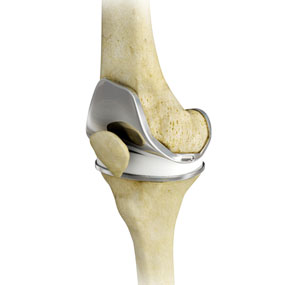Dr. Makda provided EXCEPTIONAL care to my father for his knee replacements.
Dr. Makda provided EXCEPTIONAL care to my father for his knee replacements. His attention to his patients and willingness to explain the treatment pla...

The knee is made up of the femur (thighbone), the tibia (shinbone), and patella (kneecap). The meniscus, the soft cartilage between the femur and tibia, serves as a cushion and helps absorb shock during motion. Arthritis (inflammation of the joints), injury, or other diseases of the joint can damage this protective layer of cartilage, causing extreme pain and difficulty in performing daily activities. Osteoarthritis is a type of arthritis. Your doctor may recommend surgery if non-surgical treatment options have failed to relieve the symptoms.
The exact cause of osteoarthritis is not known, however, there are several factors that are commonly associated with the onset of arthritis and may include:
Your doctor will diagnose osteoarthritis based on the medical history, physical examination, and X-rays.
X-rays typically show a narrowing of the joint space in the arthritic knee.
Total knee replacement, also called total knee arthroplasty, is a surgical procedure in which the worn out or damaged surfaces of the knee joint are removed and replaced with artificial parts.
Total knee replacement surgery is commonly indicated for severe osteoarthritis of the knee. Osteoarthritis is the most common form of knee arthritis in which the joint cartilage gradually wears away. It often affects older people.
In a normal joint, articular cartilage allows for smooth movement within the joint, whereas in an arthritic knee, the cartilage itself becomes thinner or completely absent. In addition, the bones become thicker around the edges of the joint and may form bony “spurs”. These factors can cause pain and restrict range of motion in the joint.
Your doctor may advise total knee replacement if you have:
The goal of total knee replacement surgery is to relieve pain and restore the alignment and function of your knee.
The surgery is performed under spinal or general anesthesia. Your surgeon will make an incision in the skin over the affected knee to expose the knee joint. Then, the damaged portions of the femur bone are cut at appropriate angles using specialized jigs. The femoral component is attached to the end of the femur with or without bone cement.
The surgeon then cuts or shaves the damaged area of the tibia (shinbone) and the cartilage. This removes the deformed part of the bone and any bony growths, as well as creates a smooth surface on which the implants can be attached. Next, the tibial component is secured to the end of the bone with bone cement or screws.
Your surgeon will place a plastic piece called an articular surface between the implants to provide a smooth gliding surface for movement. This plastic insert will support the body’s weight and allow the femur to move over the tibia, like the original meniscus cartilage.
The femur and the tibia with the new components are then put together to form the new knee joint.
To make sure the patella (kneecap) glides smoothly over the new artificial knee, its rear surface is also prepared to receive a plastic component.
With all the new components in place, the knee joint is tested through its range of motion. The entire joint is then irrigated and cleaned with a sterile solution. The incision is carefully closed; drains are inserted and a sterile dressing is placed over the incision.
Rehabilitation begins immediately following the surgery. A physical therapist will teach you specific exercises to strengthen your leg and restore knee movement. Knee immobilizers are used to stabilize the knee. You will be able to walk with crutches or a walker. A continuous passive motion (CPM) machine can be used to move the knee joint. Continuous passive motion is a device attached to the treated leg which constantly moves the joint through a controlled range of motion, while the patient relaxes. Your physical therapist will also provide you with a home exercise program to strengthen thigh and calf muscles.
As with any major surgery, possible risks and complications associated with total knee replacement surgery include:
If you find it difficult to perform simple activities such as walking or climbing stairs because of your severe arthritic knee pain, then total knee replacement may be an option for you. It is a safe and effective procedure to relieve pain, correct leg deformity, and help you resume your normal activities of daily living.
Dr. Makda provided EXCEPTIONAL care to my father for his knee replacements.
Dr. Makda provided EXCEPTIONAL care to my father for his knee replacements. His attention to his patients and willingness to explain the treatment pla...
I had needed knee replacements for quite awhile.
I had needed knee replacements for quite awhile. I even saw other doctors about it but never moved forward as I realized now it all was never explaine...
Dr. Makda is wonderful. He is kind, very knowledgeable and offers different types of recovery for knee problems. After 3 visits I was released from ca...
My left knee was replaced in the hands of Dr Makda last July
My left knee was replaced in the hands of Dr Makda last July. Now my right hip in 2 weeks (mid April 2019).
All went as expected. Have to do all the therapy if you want to recover fast.
All went as expected. Have to do all the therapy if you want to recover fast. Very happy with my new left knee.
100 Village Green Drive
Suite 120
Lincolnshire, IL 60069